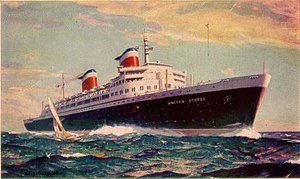United States Lines

United States Lines was a transatlantic shipping company that operated cargo services from 1921 to 1989, and ocean liners until 1969—most famously the SS United States.
1920s
The company was formed with three ships from the tonnage of the failed United States Mail Steamship Company. Two of the ships, America and George Washington, were originally German vessels that had been seized during World War I and kept as reparations. America and George Washington made New York–Bremen runs, while Centennial State ran from New York to London. One of the founders was Kermit Roosevelt, son of U.S. President Theodore Roosevelt.
Additional ships were acquired in 1922 and renamed after various US presidents. The 52,000 ton Leviathan, formerly the Vaterland and one of the largest liners in the world, was acquired in 1923.
Throughout the 1920s the line accumulated debt, and in March 1929 the line was sold to P.W. Chapman Company, and reorganized as "United States Lines Inc." of Delaware. The stock market crash made matters worse, and in 1931 the remaining ships were sold to "United States Lines Company" of Nevada.
1930s
In 1932, the Manhattan became the first ship actually built for the line, followed the next year by Washington. In 1940, a new America joined them.
1940s
In World War II, the ships were converted into troopships. The Manhattan became USS Wakefield, and the Washington became the USS Mount Vernon. The flagship America became the USS West Point. After the war, the company began to build smaller and cheaper ships, and operated a number of cargo ships, all named beginning with "American" or "Pioneer".
Duquesne Spy Ring
In 1941, two Nazi spies, Franz Joseph Stigler and Erwin Wilheim Siegler, worked for US Lines as members of SS America's crew. While on the SS America, they obtained information about the movement of ships and military defense preparations at the Panama Canal, observed and reported defense preparations in the Canal Zone, and met with other German Agents to advise them in their espionage pursuits. They operated as couriers transmitting information between the United States and German agents aboard. Stigler worked undercover as chief butcher. Both remained on the SS America until the U.S. Navy converted that ship into the USS West Point.
Stigler and Siegler, along with the 31 other German agents of the Duquesne Spy Ring, were later uncovered by the FBI in the largest espionage conviction in U.S. history. Stigler was sentenced to serve 16 years in prison on espionage charges with 2 concurrent years for registration violations; Siegler was sentenced to 10 years' imprisonment on espionage charges and a concurrent 2-year term for violation of the Registration Act.
1950s-1980s
With government subsidy for her construction, the SS United States entered service in 1952. She was (and still is) the largest ocean liner built in the United States and the fastest ocean liner ever built. She immediately set transatlantic speed records, capturing the Blue Riband from the Queen Mary. But competition from airliners brought the glory days to an end; in 1964 America was sold to Chandris Line, and United States was withdrawn from service in 1969 (it is presently docked in Philadelphia near the Ikea store).
After the termination of passenger services, United States Lines survived as a container ship line until filing for bankruptcy in 1986, due to financial difficulties brought on by too rapid expansion. Service was gradually phased out between 1986 and 1989, and the company was formally liquidated in 1992.
The name was revived briefly in 2000 and 2001 as a brand name of American Classic Voyages, but in October 2001 the company filed for bankruptcy.
Remaining as artifacts left behind by the company are several piers in New York City. One of the piers, on the corner of West 38th Street and West Side Highway, right next to the NY Waterway terminal, is now in use by the NYPD. The neon letters United States Lines are located on the west side of the pier, facing New Jersey. One letter I on the sign was working until 2002. The sign can be seen by the arriving NY Waterway ferry passengers or those taking the New York Circle Line water tour of Manhattan. As of 2008, the sign is badly deteriorated and in need of repair.
Ships

- SS Acadia
- SS America (1905) - former Amerika
- SS America (1940)
- SS American Banker
- SS American Farmer
- SS American Importer
- SS American Lark
- SS American Merchant
- SS "American Reporter"
- SS American Shipper
- SS American Trader
- SS American Traveler
- SS California (MS Uruguay)
- SS Pennsylvania (MS Argentina)
- SS Virginia (MS Brazil)
- SS Centennial State
- SS Ernie Pyle
- SS George Washington
- SS Granite State
- SS Hudson
- SS Iroquois
- SS John Ericsson
- SS Leviathan - former Vaterland
- SS Lone Star State
- SS Manhattan
- SS Marine Falcon
- SS Marine Flasher
- SS Marine Jumper
- SS Marine Marlin
- SS Marine Perch
- SS Marine Shark
- SS Marine Swallow
- SS Marine Tiger
- SS Old North State
- SS Orizaba
- SS Panhandle State
- SS Peninsular State
- SS "Pioneer Glen"
- SS Potomac
- SS President Adams
- SS President Arthur
- SS President Fillmore
- SS President Garfield
- SS President Harding
- SS President Monroe
- SS President Polk
- SS President Roosevelt
- SS President Taft
- SS President van Buren
- SS Princess Matoika, originally SS Kiautschou (German Passenger Liner, 1900).
- SS Republic
- SS Shawnee
- SS St John
- SS Susquehanna
- SS United States
- SS Washington
External links
This article includes a list of references, related reading, or external links, but its sources remain unclear because it lacks inline citations. (February 2008) |
SS American Legion (Container ship) and Flagship of US Lines after the retirement of the SS United States
